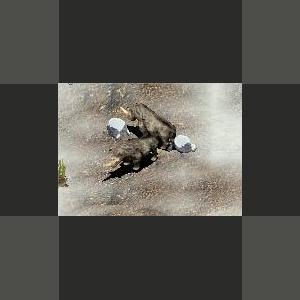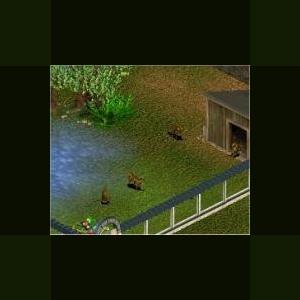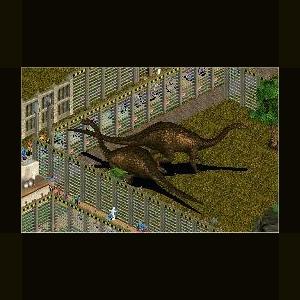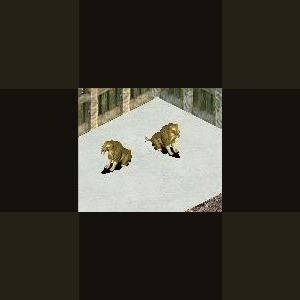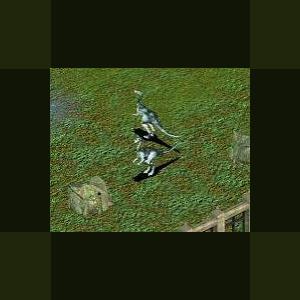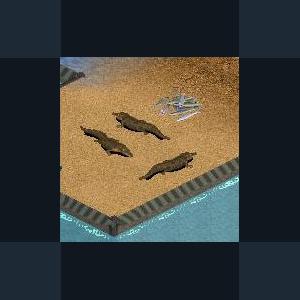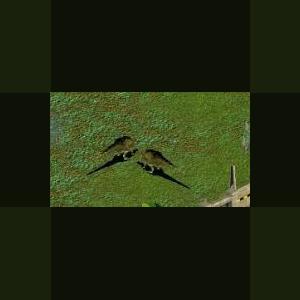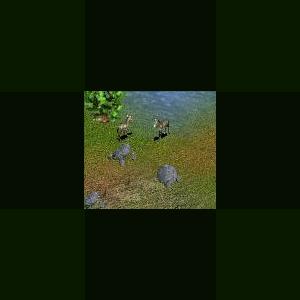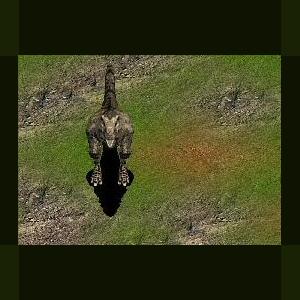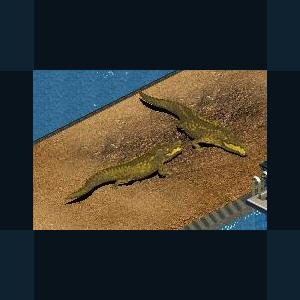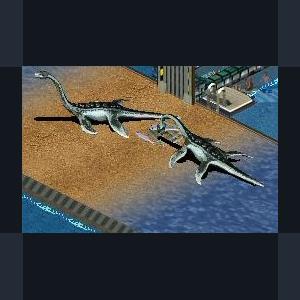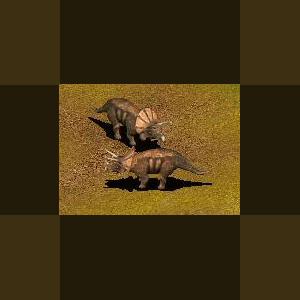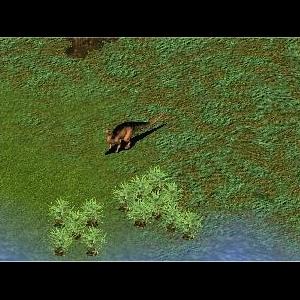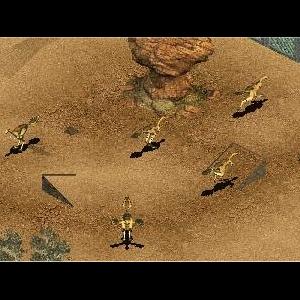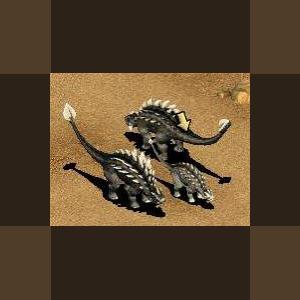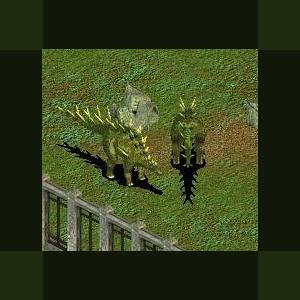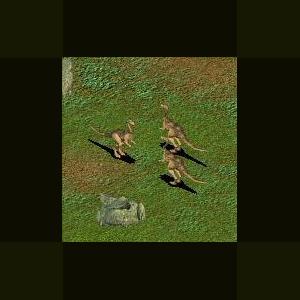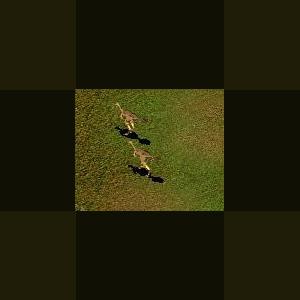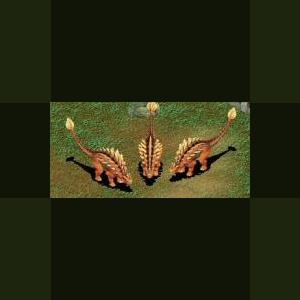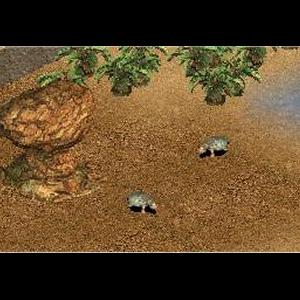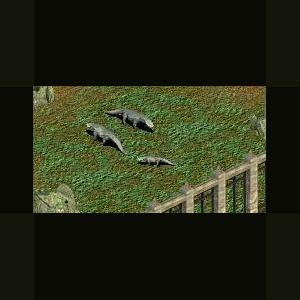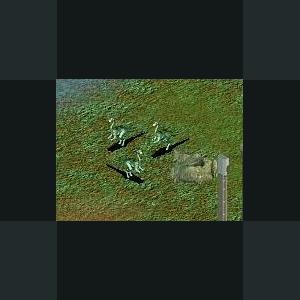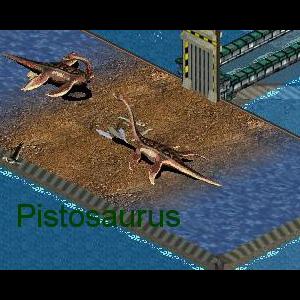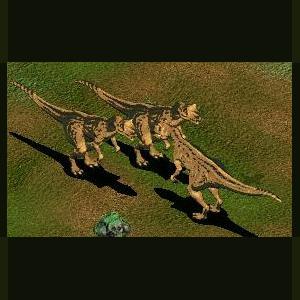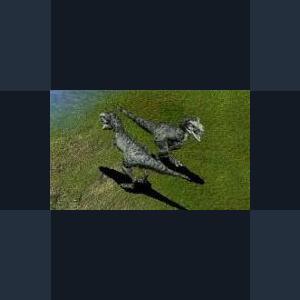Dinosaurs
Creatures from another age
241 files
-
Sinotherium by Moondawg
By Guest
Sinotherium ("Chinese Beast") was a genus of single-horned rhinoceri of the late Miocene and Pliocene.
It was ancestral to Elasmotherium, and its fossils have been found in western China. Sinotherium diverged from the ancestral genus, Iranotherium, first found in Iran, during the early Pliocene. Some experts prefer to lump Sinotherium, and Iranotherium into Elasmotherium.
258 downloads
0 comments
Updated
-
Aegyptopithecus by Ghirin
By Guest
Aegyptopithecus by Ghirin
Aegyptopithecus was an early hominid that lived in what is now modern day Egypt.
At that time, Egypt was much more wet and humid.
Reference:
http://www.johnhawks.net/weblog/fossils/ap...egyptopithecus/
256 downloads
0 comments
Updated
-
Barosaurus by Ghirin
By Guest
Barosaurus (“Heavy Lizard”) was a member of the Diplodocidae and a close relative of both Apatosaurus and Diplododus. This particular family of sauropods was named after the beam-shaped bones in their tails.
Barosaurus fossils have been been found in two locations. It ws first identified in western North America. Recently, Barosaurus fossils have been discovered in Tanzania.
References:
http://dinosauricon.com/genera/barosaurus.html
Encyclopedia of Dinosaurs and Other Prehistoric Creatures. Malam and Parker, 2002
Dinosaurs. Parker, 2003
Created by Ghirin 2004
254 downloads
0 comments
Updated
-
Dinictus by Moondawg
By Guest
Dinictis was a member of the Nimravid family, also known as "false saber-toothed cats". It had a sleek body (1.1 m. long), short legs (0.6 m. high) with only incompletely retractable claws, powerful jaws, and a long tail.
It was very similar to its close relative, Hoplophoneus. The shape of its skull is reminiscent of a felid skull rather than of the extremely short skull of the Machairodontinae. Compared with those of the more recent machairodonts, its upper canines were relatively small, but they nevertheless distinctly protruded from its mouth. Below the tips of the canines its lower jaw spread out in the form of a lobe.
Dinictis walked plantigrade (flat-footed), unlike modern felids. It looked like a small leopard and evidently its mode of life was similar to that of a leopard. It was probably not so particular about its food as its descendants, since reduction of the teeth was still in the early stages and Dinictis had not forgotten how to chew. Despite this, in its own environment it would have been a powerful predator.
It lived in the plains of North America around 40 million years ago in the late Eocene and early Oligocene. Fossils were found in Saskatchewan in Canada, and Colorado, Montana, Nebraska, South Dakota, North Dakota, Wyoming, and Oregon in the United States. Dinictis likely evolved from an early Miacis-like ancestor which lived in the Paleocene.
Made by request for Pukkie
253 downloads
0 comments
Updated
-
Troodon by Moondawg
By Guest
Tro-odon (or Troödon) was a relatively small, bird-like dinosaur from the Late Cretaceous Period (75-65 mya). Discovered in 1855, it was among the first dinosaurs found in North America.
Its name (pronounced "Tro-odon") is Greek for "wounding tooth", referring to the
dinosaur's serrated teeth (although these may actually have been adapted for a herbivorous
diet). They were formerly known as saurornithoidids. Troodon was a small dinosaur, around 2 meters (6.5 ft) in length, 1 meter (3 ft) tall, and
weighed 60 kilograms (130 lb). It had very long, slender limbs, suggesting that the animal was able to move quickly. It had long 'arms' that folded against the wall of the thorax like a bird's. It had large, retractable sickle-shaped claws on its second toes, which were raised off the ground when running. Because of these features scientists regard
Troodon as a member of the Maniraptora. Its eyes were large (perhaps suggesting nocturnal
activity) and slightly forward facing, giving Troodon some depth perception. In fact most reconstructions give Troodon eyes which point in a more forwards direction than almost any
other dinosaur, which implies that it had better binocular vision than most dinosaurs.
Their light skulls contained a capsule similar to those found in ostrich dinosaurs.
Troodon had one of the largest known brains of any dinosaur, relative to its body mass
(comparable to modern birds). Hence it is believed to have been one of the most intelligent dinosaurs, even more intelligent than mammals of that era. Eggs have also been discovered, in nests.
Troodon is known from the Judith River Formation and the upper Two Medicine Formation of Montana, the Judith River Group of Alberta, the Horseshoe Canyon Formation of Alberta, the
North Slope of Alaska, and in the famous Lance and heck Creek Formations of the USA. There
is some evidence that Troodon favored cooler climates, as it seems to have been particularly abundant
251 downloads
0 comments
Updated
-
Calsoyasuchus by Moondawg
By Guest
Calsoyasuchus
Calsoyasuchus (meaning "[Dr. Kyril] Calsoyas' crocodile") is a genus of goniopholidid mesoeucrocodylian that lived in the Early Jurassic. Its fossilzed remains were found in the Sinemurian-Pliensbachian-age Kayenta Formation on Navajo Nation land in Coconino County, Arizona, United States. Formally described as C. valliceps, it is known from a single incomplete skull which is unusually derived for such an early crocodile relative. This genus was described in 2002 by Ronald Tykowski and colleagues; the species name means "valley head" and refers to a deep groove along the midline of the nasal bones and frontal bones.
The holotype skull that would be named Calsoyasuchus was discovered in 1997 by members of an expedition composed of crews from Texas Memorial Museum of the University of Texas at Austin, the Museum of Comparative Zoology at Harvard University, and the Seba Dalkai Navajo Nation School. It was found in the middle third of the silty facies of the Kayenta Formation, near the Adeii Eechii Cliffs. The skull is missing the lower jaws, part of the palate, most of the suspensorium (the bones that make up the region where the upper and lower jaws articulate), and the occiput and braincase. Sutures between the skull bones are mostly fused. As preserved, it is about 38.0 centimeters (15.0 in) long, making its owner a moderately sized animal.
The skull was long, low, and curved so that both extremities were higher than the middle. The premaxilla bones that formed the end of the snout were enlarged to form a wide tip; there were at least four teeth in the right premaxilla and five in the left. The left maxilla (main tooth-bearing bone of the upper jaw) is more complete than the right, and had at least 29 teeth. There was a deep groove along the midline of the nasals and the frontals; the frontals were fused into a single bone, as is seen in other adult mesoeucrocodylians. Unlike derived neosuchians, it had external antorbital fenestrae. Tykowski and colleagues subjected the skull to CT scanning, which revealed internal cavities and air passages, and showed that it had a double-walled secondary palate similar to that of true crocodylians, and similar pneumatic cavities as well.
Tykowski and colleagues performed a cladistic phylogenetic analysis with their new taxon, and found that it grouped with Goniopholis, Sunosuchus, and, most closely, with Eutretauranosuchus in a weakly supported clade, Goniopholididae. They noted that the skull of Calsoyasuchus is very similar to some goniopholid skulls from the younger, Upper Jurassic Morrison Formation. Calsoyasuchus pushes back the earliest occurrence of goniopholids from the Late Jurassic into the Early Jurassic, and not only helps to bridge a temporal gap between groups of crocodyliforms, but also a morphological gap. It also implies that some groups of crocodyliforms have long undiscovered histories.
During the Sinemurian and Pliensbachian ages of the Early Jurassic, the Kayenta Formation had a diverse fauna, with the remains of caecilians, frogs, turtles, at least five other taxa of crocodylomorphs, pterosaurs, theropod, sauropodomorph, and ornithischian dinosaurs, and early relatives of mammals (tritylodontids and morganucodontids).
251 downloads
0 comments
Updated
-
Hadrosaurus by Moondawg
By Guest
Hadrosaurus (hadros + sauros = sturdy lizard) is a dubious genus of hadrosaurid dinosaur.
In 1858, a skeleton of a dinosaur from this genus was the first full dinosaur skeleton found in North America and, in 1868, it became the first ever mounted dinosaur skeleton. Hadrosaurus foulkii is the only species in this genus and has been the official state dinosaur of New Jersey since 1991.
Hadrosaurus lived near what is now the coast of New Jersey, U.S.A., in the late Cretaceous Period - around 80 million years ago. It was likely bipedal for the purposes of running, but could use its forelegs to support itself while grazing - like all hadrosaurids, Hadrosaurus was herbivorous. Its teeth suggest it ate twigs and leaves
Hadrosaurus lived near what is now the coast of New Jersey, U.S.A., in the late Cretaceous Period - around 80 million years ago. It was likely bipedal for the purposes of running, but could use its forelegs to support itself while grazing - like all hadrosaurids, Hadrosaurus was herbivorous. Its teeth suggest it ate twigs and leaves.
In 1838, William Estaugh Hopkins was digging in a marl pit (on a small tributary of the Cooper River in Haddonfield, New Jersey) when he uncovered large bones, putting them on display at his home, also in Haddonfield. In 1858 these bones sparked the interest of a visitor, William Parker Foulke. The skeleton was dug out from the marl pit in 1858 by Foulke. In the same year, the species was named by paleontologist Joseph Leidy from an almost complete set of limbs, along with a pelvis, several part of the feet, twenty-eight vertebrae (including eighteen from the tail), eight teeth and two small parts of the jaw. Leidy recognized that these bones were from a dinosaur by their similarity to those of Iguanodon, discovered in England some decades before, but the skeleton of Hadrosaurus was far more complete. Leidy's monograph Cretaceous Reptiles of the United States, describing Hadrosaurus more completely and with illustrations, was written in 1860 but the American Civil War delayed its publication until 1865. Leidy reconstructed Hadrosaurus as a biped, in contrast to the view at the time that such dinosaurs were quadrupedal. The entire skeleton was completely assembled in 1868 by a team including English sculptor and naturalist Benjamin Waterhouse Hawkins and was put on display at Philadelphia Academy of Natural Sciences, where it remains available for public viewing.
248 downloads
0 comments
Updated
-
Hipparion by Moondawg
By Guest
Hipparion (Greek, "pony") is an extinct genus of horse.
It resembled the modern horse, but still had vestigal outer toes (in addition to its hoof). These did not touch the ground. Hipparion was about 1,40 m (4 ft 8 in) tall at the shoulder.
Must have Dino Digs and/or Complete Collection in order for food to show up.
246 downloads
0 comments
Updated
-
Daspletosaurus by Moondawg
By Guest
Daspletosaurus is closely related to the much larger and more recent Tyrannosaurus. Like most known tyrannosaurids, it was a multi-ton bipedal predator equipped with dozens of large, sharp teeth. Daspletosaurus had the small forelimbs typical of tyrannosaurids, although they were proportionately longer than in other genera.
As an apex predator, Daspletosaurus was at the top of the food chain, probably preying on large dinosaurs like the ceratopsid Centrosaurus and the hadrosaur Hypacrosaurus. In some areas, Daspletosaurus coexisted with another tyrannosaurid, Gorgosaurus, though there is some evidence of niche differentiation between the two. While Daspletosaurus fossils are rarer than other tyrannosaurids, the available specimens allow some analysis of the biology of these animals, including social behavior, diet and life history.
While very large by the standard of modern predators, Daspletosaurus was not the largest tyrannosaurid. Adults could reach a length of 8–9 meters (26–30 ft) from snout to tail. Mass estimates have centered around 2.5 tonnes (2.75 short tons)but have ranged between 1.8 tonnes (2 tons)and 3.8 tonnes (4.1 tons).
Life restoration of Daspletosaurus. Daspletosaurus had a massive skull that could reach more than 1 meter (3.3 ft) in length. The bones were heavily constructed and some, including the nasal bones on top of the snout, were fused for strength. Large fenestrae (openings) in the skull reduced its weight. An adult Daspletosaurus was armed with about six dozen teeth that were very long but oval in cross section rather than blade-like. Unlike its other teeth, those in the premaxilla at the end of the upper jaw had a D-shaped cross section, an example of heterodonty always seen in tyrannosaurids. Unique skull features included the rough outer surface of the maxilla (upper jaw bone) and the pronounced crests around the eyes on the lacrimal, postorbital, and jugal bones. The orbit (eye socket) was a tall oval, somewhere in between the circular shape seen in Gorgosaurus and the 'keyhole' shape of Tyrannosaurus.
Daspletosaurus shared the same body form as other tyrannosaurids, with a short, S-shaped neck supporting the massive skull. It walked on its two thick hindlimbs, which ended in four-toed feet, although the first digit (the hallux) did not contact the ground. In contrast, the forelimbs were extremely small and bore only two digits, although Daspletosaurus had the longest forelimbs in proportion to body size of any tyrannosaurid. A long, heavy tail served as a counterweight to the head and torso, with the center of gravity over the hips.
242 downloads
0 comments
Updated
-
Dyrosaurus by Moondawg
By Guest
Dyrosaurus was an extinct genus of dyrosaurid crocodyliform from the Eocene of North Africa. The type species D. phosphaticus possessed slender jaws with numerous recurved teeth, indicative of a primarily fish diet (similar to the extant gharial).
The dyrosaurids represent a family of crocodiles existing from the late Cretaceous to the early Tertiary,which were outwardly similar to the modern gavials with their long,narrow,toothy snouts. They were strong swimmers and hunted fish in the shallow coastal waters or brackish river mouths.
The long narrow jaws of Dyrosaurus are full of sharp teeth and form an ideal fish trap.
The tail is a broad swimming organ and the limbs are quite long,indicating that it
spent as much time on land as it did in the water.The typical crocodile armor is
present but it is reduced compared with others of the crocodile group.The long skull
is quite lightweight with large gaps between the bones.
241 downloads
0 comments
Updated
-
Muraenosaurus by Moondawg
By Guest
Muraenosaurus ('moray eel lizard') is an extinct genus of sauropterygian reptile belonging to the plesiosaur order. It lived in Late Jurassic Europe, and grew to 30 feet (8 m) long. Half of its length was its neck, which consisted of 44 vertebrae. Its skull was small.
240 downloads
0 comments
Updated
-
Chasmosaurus by Moondawg
By Guest
Chasmosaurus (KAZ-mo-sawr-us) is a ceratopsid dinosaur genus from the Upper Cretaceous Period of North America.
Ceratopsians are split into two subfamilies by taxonomists; those with short frills
(centrosaurines), such as Centrosaurus and those with long frills (chasmosaurines), of
which Chasmosaurus was one. In addition to the larger frill, the long-frilled ceratopsians
typically had longer faces and jaws and it is suggested by some paleontologists that they
were more selective about the plants they ate. Long frills were a relatively late
development in dinosaur evolution, since even Chasmosaurus dates from the late Cretaceous
Period, 76 to 70 million years ago. The frill of Chasmosaurus has been described as
"heart-shaped", since its bone structure consists of two large 'loops' from a central bone.
Some finds include a number of smaller ossifications (called epoccipitals), which may have
grown from the perimeter of the frill. The frill may also have been brightly colored, to
draw attention to its size or as part of mating display. However, the frill was so large
and yet so flimsy (since it was mainly skin stretched between the bones) that it could not
have provided much functional defense. It is possible that it was simply used to appear
imposing or conceivably for thermoregulation. In the event of a chasmosaur herd being
attacked by a predator (such as Tyrannosaurus), the males could have formed a ring and,
with all the frills facing outwards, would have presented a formidable sight.
A drawing of Chasmosaurus.Like many ceratopsians, chasmosaurs had three main facial horns - one on the nose and two on the brow. Different fossil finds have produced inconclusive
results - one species of Chasmosaurus, named C. kaiseni, bore long brow horns, while C. belli had only short ones. Although these were initially named as different species, it now seems possible that the long horns belonged to males and the shorter horns to females.
Interestingly, a Chasmosaurus specimen recovered by Sternberg was accompanied by
fossilized skin.The skin appears to have had many bony knobs (osteoderms) in evenly spaced rows, with five or six sides per knob. Unfortunately, nothing can be learned about the coloration of Chasmosaurus from the known fossil skin samples.
Inspired by the Zoo Tek Brains Trust
238 downloads
Updated
-
Draconyx by Ghirin
By Guest
Draconyx
Author: Ghirin
Draconyx's ("Dragon Claw") fossils were found in Portugal. It was similar in size and build to Camptosaurus.
*Inspired by the Zoo Tycoon Brain Trust at the Zoo Tek Evolved Forums.
237 downloads
0 comments
Updated
-
Shuvuuia by Ghirin
By Guest
Shuvuuia was a member of the bird-like alvarezsaurid group. A distinguishing feature of this group was the short arm ending in a large claw. This might be an adaptation for digging for food.
Reference:
The Illustrated Ecyclopedia of Dinosaurs by Dougal Dixon. 2006
www.wikipedia.com
Created by Ghirin 2006
237 downloads
0 comments
Updated
-
Gobisaurus by Moondawg
By Guest
Gobisaurus is an ankylosaur from the Upper Cretaceous Ulansuhai Formation (Nei Mongol Zizhiqu) of China.
The holotype consists of a skull and as yet undescribed postcranial remains. Along with its sister taxon Shamosaurus, Gobisaurus is "nested deep within the ankylosaurid lineage as the first successive outgroup to (the subfamily) Ankylosaurinae" (Vickaryous et. al., 2004). This is a large ankylosaur, with a skull measuring 46 cm. in length and 45 cm. across. The name means "Gobi (Desert) lizard," referring to its discovery by the Sino-Soviet Expeditions (1959–1960) in the Gobi Desert of Mongolia. The genus is monotypic, containing only G. domoculus.
237 downloads
0 comments
Updated
-
Chialingosaurus by Moondawg
By Guest
Chialingosaurus (meaning "Chialing Lizard") was a type of stegosaur similar to Kentrosaurus from the Upper Shaximiao Formation, Late Jurassic beds in Sichuan Province in China.
Its age makes it one of the oldest species of stegosaurs, living about 160 million years ago. Since it was an herbivore, scientists think that Chialingosaurus probably ate ferns and cycads, which were plentiful during the period when Chialingosaurus was alive. Its name is taken from the Chialing River in southern China. Perhaps growing up to 13 ft (4m) long and weighing just 330 pounds (150 Kg), much less than other later stegosaurs.
Collected by the geologist Kuan in 1957 in Quxian County, the dinosaur was named by paleontologist C. C. Young two years later, although only very incomplete fossilized remains of Chialingosaurus have been found, and those fossil remains belong to a juvenile. In 1969, Rodney Steel suggested that Chialingosaurus might have actually been an early ancestor of other stegosaurs, but it is difficult to tell: the type specimen, Chialingosaurus kuani is known from only one partial skeleton, the original material having been supplemented in 1978 by Zhou of the Municipal Museum of Chongqing.
235 downloads
0 comments
Updated
-
Agilisaurus by Moondawg
By Guest
Acrocanthosaurus (pronounced ak-ro-KAN-tho-SAWR-us; meaning 'high-spined lizard') is a genus of allosauroid theropod dinosaur that existed in what is now North America during the mid-Cretaceous Period
The skull of Acrocanthosaurus, like most other allosauroids, was long, low and narrow. The weight-reducing opening in front of the eye socket (antorbital fenestra) was quite large, more than a quarter of the length of the skull and two-thirds of its height. The outside surface of the maxilla (upper jaw bone) and the upper surface of the nasal bone on the roof of the snout were not nearly as rough-textured as those of Giganotosaurus or Carcharodontosaurus. Long, low ridges arose from the nasal bones, running along each side of the snout from the nostril back to the eye, where they continued onto the lacrimal bones. This is a characteristic feature of all allosauroids. Unlike Allosaurus, there was no prominent crest on the lacrimal bone in front of the eye. The lacrimal and postorbital bones met to form a thick brow over the eye, as seen in carcharodontosaurids and the unrelated abelisaurids. Nineteen curved, serrated teeth lined each side of the upper jaw, but a tooth count for the lower jaw has not been published. Acrocanthosaurus teeth were wider than those of Carcharodontosaurus and did not have the wrinkled texture that characterized the carcharodontosaurids. The dentary (tooth-bearing lower jaw bone) was squared off at the front edge, as in Giganotosaurus, and shallow, while the rest of the jaw behind it became very deep. Acrocanthosaurus and Giganotosaurus shared a thick horizontal ridge on the outside surface of the surangular bone of the lower jaw, underneath the articulation with the skull.
235 downloads
Updated
-
Bambiraptor by Moondawg
By Guest
The Bambiraptor skeleton was discovered in 1995 by 14-year-old fossil hunter Wes Linster, who was looking for dinosaur bones with his parents near Glacier National Park in Montana. Linster told Time Magazine that he uncovered the skeleton on a tall hill and was amazed at his discovery. "I bolted down the hill to get my mom because I knew I shouldn't be messing with it", he said. The bones that Linster discovered on that hilltop led to the excavation of a skeleton that was approximately 95 percent complete. Because of its completeness Florida Paleontology Institute Director Martin Shugar compared it to the 'Rosetta Stone' that enabled archaeologists to translate Egyptian hieroglyphics. Yale paleontologist John Ostrom, who reintroduced the theory of bird evolution from dinosaurs after his 1964 discovery of Deinonychus in Wyoming, agreed, calling the specimen a "jewel", and telling reporters that the completeness and undistorted qualities of the bones should help scientists further understand the dinosaur-bird link. The specimen is currently housed at the American Museum of Natural History, New York.
During the conference where Bambiraptor was first introduced, the dinosaur reconstruction specialist Brian Cooley portrayed Bambiraptor as having feathers, despite the fact that no feathers were found with the fossil itself. His decision was influenced by the fact that because Bambiraptor within a cladistic analysis was a member of a group, Paraves, that contained feathered true birds and that was the sister taxon of Oviraptorosauria, a group that also had feathered forms (e.g. Caudipteryx), Bambiraptor most likely had feathers too due to phylogenetic bracketing. Most paleontologists support Cooley's view, and subsequent discoveries confirmed that small dromaeosaurid dinosaurs like Bambiraptor were fully covered in feathers.
Research done at Lamar State College in Orange, Texas has indicated that Bambiraptor may have had opposable front claws and a forelimb maneuverability that could reach its mouth. This would have given the animal the ability to "hold" food in its front limbs and place it in its mouth, in a similar manner to some modern-day small mammals.
Bambiraptor skull in the Oxford University Museum of Natural History.Bambiraptor had a brain size in the lower range of modern birds. Because of its enlarged cerebellum, which may indicate higher agility and higher intelligence than other dromaeosaurs, David A. Burnham has hypothesized that Bambiraptor feinbergi may have been arboreal. Life in the trees may have required evolutionary pressure that resulted in a larger brain. Burnham also offers an alternative hypothesis that a larger brain could be selected for as a result of hunting more agile prey items such as lizards and mammals. Bambiraptor had the largest brain for its size of any dinosaur yet discovered, although the brain size may be due to its age, because juvenile animals tend to have larger brain-to-body ratios compared to adults. It also had very long arms and a well-developed wishbone.
233 downloads
0 comments
Updated
-
Euoplocephalus by Moondawg
By Guest
It has been said that the herbivores and carnivores forced each other to evolve in a rapid escalating battle of armor vs. firepower.
If this is the case, and it seems very likely it is, then a very successful biological armored vehicle was Euoplocephalus.
Pronounced you-op-luh-SEF-uh-lus the name means "well protected head. This tank-like creature was from the late Cretaceous and is in the Ankylosaur family. It was believed to weigh in the 3 to 5 ton range and averaged 20 feet in length and maybe 8 or 9 feet in width.
What is unusual is that this heavily armored dinosaur was very likely totally immune to the attack of the large carnivores like T rex. It's strategy may well have been to first try and use it's bony and spiked tail to dissuade its attacker and then if that didn't work to simply hanker down in the sand or earth, protect its head and just out wait its adversary. As a side note there have been T rex leg bones found that were fractured in just the manner that Euoplocephalus would have done if it connected in a fight.
This species was the long end product of a very successful weeding out of less successful creatures. If it was for the Extinction Event that took out all of the dinosaurs this creatures descendants may well have been alive to this day. That is if the plants continued to survive. At this time (app. 70 MYA) we would have found cycads, tree ferns, bonze pines, katsura trees, and large conifers. but perhaps the defining tree would have been the bald cypress. These plants only thrived in humid and warm conditions and this is where these armored dinosaurs would have flourished.
Inspired by the Zoo Tek Brains Trust
230 downloads
0 comments
Updated
-
Proganochelys by Ghirin
By Guest
Proganochelys by Ghirin
Proganochelys, the earliest known member of the tortoise family, lived in Europe during the Triassic period.
Its body is very similar to that of modern land tortoises, but Proganochelys could not retract its head or legs into its shell.
Reference:
The Simon and Schuster Encyclopedia of Dinosaurs and Prehistoris Creatures. Cox, Savage, Gardiner, Harrison, and Palmer, 1999.
229 downloads
0 comments
Updated
-
Chasmatosaurus by Moondawg
By Guest
Chasmatosaurus is an extinct genus of archosauriform reptile that grew about 4 m (12 ft 8 in) long from the Early Triassic of China.
Also called Proterosuchus, Chasmatosaurus was a crocodile-like creature that probably hunted like its extant descendants, attacking drinking prey on the waterside. Its upper jaw arched down at the front, and the creature had teeth on its palate- a primitive trait. it had a main cameo in walking with monsters attacking a herd of lystrosaurus. it is a possibility that chasmatosaurus is an ancestor of crocodillians.
228 downloads
0 comments
Updated
-
Dryosaurus by Moondawg
By Guest
Dryosaurus
Dryosaurus (DRY-oh-sawr-us) meaning 'oak lizard', due to the vague oak shape of its cheek teeth (Greek dryo meaning 'oak' and sauros meaning 'lizard') was a genus of an ornithopod dinosaur that lived in the Late Jurassic Period. It was an iguanodont (formerly classified as a hypsilophodont). Fossils have been found in the western United States and Tanzania and were first discovered in the late 19th century. The Tanzanian site proved to be an especially fertile hunting ground for Dryosaurus fossils, this specimen was previously called Dysalotosaurus (Lost wood reptile). An expedition led by German paleontologist Werner Janensch found a great many fossils that represented Dryosaurus at all stages of development.
Dryosaurus had a long neck, long, slender legs and a long, stiff tail. Its 'arms', however, with five 'fingers' on each 'hand', were short. It was about 8 to 14 feet (2.4 to 4.3 m) long, five feet (1.5 m) tall (at the hips) and weighed 170 to 200 pounds (77 to 91 kg). Its eyes were quite large, leading many to believe that it possessed excellent eyesight.
Dryosaurus had a horny beak and cheek teeth and, like other ornithopods, was a herbivore. Some scientists suggest that it had cheek-like structures to prevent the loss of food while the animal processed it in the mouth. It was probably a herd animal, which raised and protected its young after hatching.
A quick and agile runner with strong legs, Dryosaurus used its stiff tail as a counter-balance. It probably relied on its speed as a main defense against carnivorous dinosaurs.
Its intelligence, as measured by its brain-to-body ratio, was midway when compared to other dinosaurs.
228 downloads
0 comments
Updated
-
Pistosaurus by Moondawg
By Guest
Pistosaurus longaevus is an extinct genus of aquatic sauropterygian reptile belonging to the plesiosaur order.
PISTOSAURUS
(pronounced PIST-oh-SAWR-us) Pistosaurus was a nothosaur, a reptile with flipper-like limbs that lived both on land and in the water. It was about 10 feet (3 m) long with a very long neck, four long, paddle-shaped flippers, a streamlined body, and many sharp, pointed teeth in long jaws. Fossils have been found in France and Germany. It lived during the mid-Triassic period. It was not dinosaur
228 downloads
0 comments
Updated
-
Megalosaurus by Moondawg
By Guest
Megalosaurus (meaning "Great Lizard", from Greek,megalo- meaning 'big', 'tall' or 'great' and sauros meaning 'lizard') is a genus of large meat-eating theropod dinosaurs of the Middle Jurassic Period (Bathonian) o
Megalosaurus was the first dinosaur to be described. Part of a bone was recovered from a limestone quarry at Cornwell near Chipping Norton, Oxfordshire, England in 1676. The fragment was sent to Robert Plot, Professor of Chemistry at the University of Oxford and first curator of the Ashmolean Museum, who published a description in his Natural History of Oxfordshire in 1677. He correctly identified the bone as the lower extremity of the femur of a large animal and he recognized that it was too large to belong to any known species; he considered it to be the thigh bone of a giant. The bone has since been lost but the illustration is detailed enough to identify it clearly as the femur of a Megalosaurus.
The Cornwell bone was described again by Richard Brookes in 1763. He named it Scrotum humanum, while describing its similar appearance to a pair of human testicles. The label was not considered to be a "name" for the animal in question at the time, and was not used in subsequent literature. Technically, the name was published after the advent of binomial nomenclature, and although this name theoretically had priority over Megalosaurus, the rules of the ICZN state that if a name falls into disuse for 50 years after publication, it is no longer in competition for priority. Therefore, the name Scrotum humanum is a nomen oblitum, or "forgotten name".
More discoveries were made, starting in 1815, again at the Stonesfield quarry. They were acquired by William Buckland, Professor of Geology at the University of Oxford and dean of Christ Church. He did not know to what animal the bones belonged but, in 1818, after the Napoleonic Wars, the French comparative anatomist Georges Cuvier visited Buckland in Oxford and realised that the bones belonged to a giant lizard-like creature. Buckland then published descriptions of the bones in Transactions of the Geological Society, in 1824 (Physician James Parkinson had described them in an article in 1822).
226 downloads
0 comments
Updated
-
Aviatyrannis by Moondawg
By Guest
Aviatyrannis is a genus of tyrannosaurid dinosaur from the Kimmeridgian stage of the Late Jurassic found in Portugal.
It was described by Oliver Rauhut in 2003. The name means "Jurassic grandmother tyrant". It is one of the oldest tyrannosaurs ever found, the oldest being Guanlong (or Iliosuchus if it is indeed tyrannosauroid).
Aviatyrannis was perhaps a contemporary of another ancient tyrannosaur, the American Stokesosaurus. Aviatyrannis was even originally assigned to Stokesosaurus, and its fragmentary remains maintain the question of their synonymity open.
Like other early tyrannosaurs, Aviatyrannis was rather small. The holotype, for example, is an ilium only 90 millimeters long. The type species, Aviatyrannis jurassica, was described by Rauhut in 2003.
Inspired by the Zoo Tek Brains Trust
226 downloads
Updated

